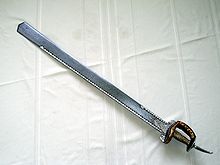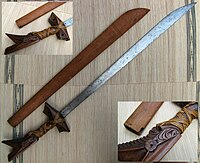As steel technology improved, single-edged weapons became popular throughout Asia. Derived from the Chinese Jian or dao, the Korean hwandudaedo are known from the early medieval Three Kingdoms. Production of the Japanese tachi, a precursor to the katana, is recorded from c. AD 900 (see Japanese sword).[29]
Japan was famous for the swords it forged in the early 13th century for the class of warrior-nobility known as the Samurai. The types of swords used by the Samurai included the ōdachi(extra long field sword), tachi (long cavalry sword), katana (long sword), and wakizashi(shorter companion sword for katana). Japanese swords that pre-date the rise of the samurai caste include the tsurugi (straight double-edged blade) and chokutō (straight one-edged blade).[30] Japanese swordmaking reached the height of its development in the 15th and 16th centuries, when samurai increasingly found a need for a sword to use in closer quarters, leading to the creation of the modern katana.[31]
Western historians have said that Japanese katana were among the finest cutting weapons in world military history.[32][33][34]
Indian subcontinent[edit]
The Khanda is a double-edge straight sword. It is often featured in religious iconography, theatre and art depicting the ancient history of India. Some communities venerate the weapon as a symbol of Shiva. It is a common weapon in the martial arts in the Indian subcontinent.[35] Khanda often appears in Hindu, Buddhist and Sikh scriptures and art.[36] In Sri Lanka, a unique wind furnace was used to produce the high quality steel. This gave the blade a very hard cutting edge and beautiful patterns. For these reasons it became a very popular trading material.[37]
The Urumi: (Tamil: சுருள் பட்டாக்கத்தி surul pattai, lit. curling blade; Sinhalese: එතුණු කඩුව ethunu kaduwa; Hindi: aara) is a longswordwith a flexible whip-like blade from India. Originating in the country's southern states, it is thought to have existed as far back as the Maurya dynasty (322–185 BC). The urumi is considered one of the most difficult weapons to master due to the risk of injuring oneself. It is treated as a steel whip,[38] and therefore requires prior knowledge of that weapon.
The Firangi: (/fəˈrɪŋɡiː/) derived from the Arabic term for a Western European a "Frank") was a sword type which used blades manufactured in Western Europe and imported by the Portuguese, or made locally in imitation of European blades. Because of its length the firangi is usually regarded as primarily a cavalry weapon. The sword has been especially associated with the Marathas, who were famed for their cavalry. However, the firangi was also widely used by Sikhs and Rajputs.[39]
The Talwar: (Hindi: तलवार) is a type of curved sword from India and other countries of the Indian subcontinent, it was adopted by communities such as Rajputs, Sikhs and Marathas, who favored the sword as their main weapon. It became more widespread in the medieval era.[40][41]
Southeast Asia[edit]
In Indonesia, the images of Indian style swords can be found in Hindu gods statues from ancient Java circa 8th to 10th century. However the native types of blade known as kris, parang, klewang and golok were more popular as weapons. These daggers are shorter than sword but longer than common dagger.
In The Philippines, traditional large swords known as the Kampilan and the Panabas were used in combat by the natives. A notable wielder of the kampilan was Lapu-Lapu, the king of Mactan and his warriors who defeated the Spaniards and killed Portuguese explorer Ferdinand Magellan at the Battle of Mactan on 27 April 1521.[42] Traditional swords in the Philippines were immediately banned, but the training in swordsmanship was later hidden from the occupying Spaniards by practices in dances. But because of the banning, Filipinos were forced to use swords that were disguised as farm tools. Bolos and baliswords were used during the revolutions against the colonialists not only because ammunition for guns was scarce, but also for concealability while walking in crowded streets and homes. Bolos were also used by young boys who joined their parents in the revolution and by young girls and their mothers in defending the town while the men were on the battlefields. During the Philippine–American War in events such as the Balangiga Massacre, most of an American company was hacked to death or seriously injured by bolo-wielding guerillas in Balangiga, Samar.[43] When the Japanese took control of the country, several American special operations groups stationed in the Philippines were introduced to the Filipino Martial Arts and swordsmanship, leading to this style reaching America despite the fact that natives were reluctant to allow outsiders in on their fighting secrets.[44]









0 Comments